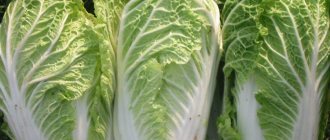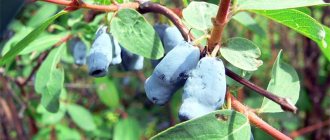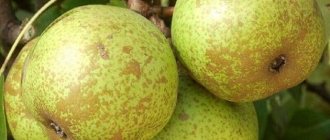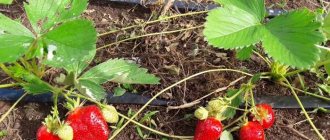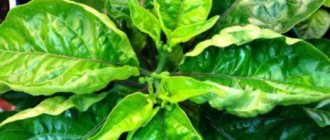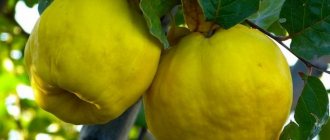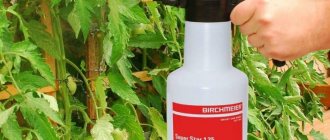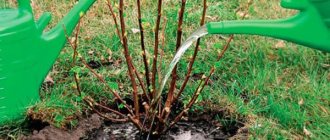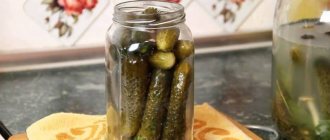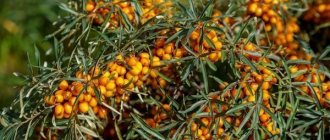What to do with Japanese quince. Caring for Japanese quince in autumn
Chaenomeles is unpretentious.
However, many people complain that they cannot grow healthy bushes. Such that they do not have dry branches, are beautifully shaped, bloom and bear fruit profusely. As a rule, this is a consequence not only of the wrong choice of planting site and care errors, but also of inattention to chaenomeles in the autumn. Chaenomeles pruning. At the end of summer, I walk along a Japanese quince hedge with pruning shears and garden shears in hand. They are needed in order to correct the even line of bushes planted in a row. It is necessary to remove all dried, broken and old branches, which are easily distinguished by the darkened bark. I don’t need shoots that protrude to the sides or are too long.
Chaenomeles tolerates pruning painlessly. Closer to autumn, tillering slows down, so the plant retains its shape longer. I carry out the second autumn pruning after all the “apples” have been collected. They cannot be left over the winter. It is more convenient to care for Japanese quince with thick gloves, since the branches of most species have thorns.
Japanese quince is a plant that can even be used to create bonsai. I saw a wonderful composition of blooming chaenomeles, turned into a dwarf tree, moss and stones.
Chaenomelis hedge
Watering and fertilizing. On the eve of strong night frosts in autumn, it is advisable to moisten the soil under young bushes. After harvesting the fruits, I wash off the dust from the leaves that has accumulated over the summer with a strong stream. The last watering occurs at the end of October - November (depending on the weather). It needs to be done before the cold pre-winter arrives.
In September, I feed Japanese quince with potassium-phosphorus fertilizers. At the same time, I loosen the soil under the bushes and add well-decomposed compost.
Warming for the winter. The unpretentiousness of Japanese quince increases with age. Young plants are less resistant than adults. I remember how I carefully mulched the soil under the young bushes. She covered them with spruce branches and covered them with snow. But they still managed to freeze the tips of the branches. With mature bushes there is less hassle. They have already grown a solid root system, a guarantee of their recovery.
If there are only a few Chaenomeles bushes growing on the site, and there is little snow in winter, then before the start of winter, it is advisable to bend all flexible branches of tall forms to the ground. There is no need to be afraid that some of the shoots will freeze. They are cut out in the spring during thinning and formation of chaenomeles. Young shoots soon appear, thanks to which the plant quickly recovers. Low-growing and creeping forms often have most of the branches spread out, so even a small layer of snow completely covers the bush.
An overgrown Japanese quince, found under the snow, can even withstand severe frosts. The bigger the snowdrift, the better. They say that young Japanese quince bushes are a delicacy for hares. Therefore, where they exist, it is better to cover chaenomeles with spruce branches.
Reproduction of Chaenomeles. Japanese quince is propagated by root suckers, layering, cuttings (summer), dividing the bush and seeds. The lower branch, randomly sprinkled with soil, takes root and produces vertical shoots. In place of the dug up adult bush, young shoots will appear for a long time from the roots remaining in the ground.
I have always liked Japanese quince. The decision to make a hedge from this wonderful plant came after I saw how easily and quickly Chaenomeles reproduces. Pre-winter sowing of seeds from several fruits produced many seedlings the very next year. A year later I had excellent planting material, which was enough to plant a hedge. All that remained was to transplant the seedlings from the garden bed to a permanent place. Of course, valuable forms of quince (with double flowers, rare colors, etc.) have to be propagated vegetatively (by summer cuttings, root suckers, layering or dividing the bush). Freshly harvested seeds are sown in the fall, and stratified seeds are sown in the spring.
Ways to rejuvenate wood
Thanks to constant pruning, the fruiting period of quince can be increased to fifty years. It is this process that leads to the rejuvenation of the tree. It goes like this:
- Branches that are three years old are pruned.
- Shoots that were formed at the age of 4–7 years are removed.
- If deep pruning occurs. It is necessary to remove branches that were formed between the ages of 10 and 12 years.
- The main thing is that rejuvenation of Japanese quince occurs only if 2/3 of all branches are removed.
Japanese quince or Chaenomeles is naturally endowed with unforgettable beauty, and the fruits are beneficial for human health. It can deservedly take pride of place in any orchard. With proper care and care, the first harvest can be obtained within 3-4 years after planting in a new place. To grow a fruitful tree you need to follow all the rules. Then the tree’s productivity will be high, and the fruits will delight with their unforgettable taste.
Sources:
https://ekosad-vsem.ru/ajva-posadka-i-uhod-v-otkrytom-grunte/ https://zelenj.ru/ajva-yaponskaya-osenyu.html https://ogorod-bez-hlopot.ru /kak-vyrashhivat-ajvu-osenyu.html
Japonica. Preparing the soil and planting Chaenomeles
Japanese quince grows on any soil, from light to clayey, from slightly acidic to alkaline (pH = 6-8). On highly alkaline soils, the crop slows down, reduces yield, and changes the color of the leaves. Naturally, it develops better on fertile soils with a pH of 6-7.
Japanese quince can be planted in a permanent place in spring and autumn, with 2-year-old seedlings. Planting holes are prepared in size according to the size of the root system, placing them every 1.5-2.0 m. I planted the purchased seedlings in the spring.
Stagnant groundwater can cause rotting of the root system. In this case, choose a higher place or make good drainage. There was no need for drainage for planting the Chaenomeles seedlings I bought.
Japanese quince grows patiently without fertilizers, but when applied, it produces larger fruits and a larger harvest. Therefore, on soils that are unfavorable in composition and fertility, organic and mineral fertilizers are applied before planting to improve their physical and chemical properties. I mixed a bucket of humus with the soil (you can use mature compost) with 150 g of superphosphate and 40 g of potassium sulfate per planting hole. The mixture was mixed well. A Japanese quince seedling was placed in the center of the planting hole and filled to the middle with soil mixture. She poured out almost a bucket of water and, after soaking it in, added the rest of the mixture to the top of the hole. The root collar was left at soil level. Deepening of the root collar leads to abundant shoot formation.
How to transplant correctly
Japanese quince does not tolerate transplantation well, so it is best to initially plant it in an area with suitable conditions for growth.
But the plant must be moved to a new location in the following cases:
- the area where the bush grows has been flooded;
- Chaenomeles suffered from root rot;
- the plant grows poorly and does not bear fruit.
When replanting, you need to choose the right place for the bush, prepare the soil and perform the procedure of moving the quince according to a certain algorithm.
Selecting a location
In order for Japanese quince to grow well and bear fruit regularly, you need to find a site with suitable conditions for its cultivation.
The location is selected according to the following criteria:
- good lighting - the shrub does not develop well in the shade;
- the distance from trees and buildings is at least 1 m - they should not shade the plant;
- location on a small hill - moisture can accumulate in the lowlands around chaenomeles, causing rotting of the roots;
- lack of draft, protection from wind - under the influence of cold air currents, the plant’s immunity weakens;
- moderately moist, fertile and slightly acidic soil (pH 6.5) - promotes normal development of the root system.
Selecting tools for work
To prepare Japanese quince for transplantation and to correctly perform the procedure of moving the plant, it is necessary to carry out a number of actions.
To do this you will need the following tools and devices:
- a sharpened garden shovel for digging up bushes;
- a fabric bag or plastic bag corresponding to the size of the earthen ball around the roots - needed for carrying chaenomeles to a new place;
- rake - with their help they form an earthen embankment;
- rope, long cord - for tying shoots and fixing a bag or package around an earthen clod;
- garden wheelbarrow - for transporting shrubs to a new planting site.
To prepare the plant for transplantation you must:
- Dig the bush in a circle to expose the root collar.
- Leaving the quince in the ground, use a shovel to cut off the too long shoots of the roots along the diameter of the dug-up trunk circle - thanks to this procedure, the root system will not grow to the sides.
- Pour chaenomeles with 10 liters of warm water. Form a small earthen mound around it.
- Leave the bush in this state until autumn, following all standard recommendations for caring for the plant.
Soil preparation
Simultaneously with preparing the plant for replanting, you need to begin arranging a new site for it. The soil on it is thoroughly cleaned of debris and plant debris, and then dug up with the addition of 10 kg of compost per 1 m², 40 g of phosphorus and potassium fertilizers. The planting hole in the new area is formed about a month before the quince is transplanted. Its size depends on the diameter of the root system of the shrub.
The earth obtained by digging a hole is mixed with the following components:
- 1 bucket of humus;
- 0.5 liters of wood ash;
- 300 g superphosphate;
- 30 g of potassium nitrate.
Transplantation process
The procedure for removing quince from the ground and moving it to a new place must be carried out carefully so as not to damage the roots and branches of the plant.
The step-by-step algorithm for replanting shrubs includes the following steps:
- Clear the soil above the rhizome of weeds and the earthen mound so that the previously outlined outline around the plant is visible.
- Water the soil ball generously around the roots of the bush to make the soil softer.
- Carefully dig up the plant, moving along the outlined contour. In this case, you need to slightly loosen the quince each time the tip of the shovel is immersed in the ground.
- Place the root system of the bush in the prepared bag, maintaining the integrity of the earthen ball. Secure the covering material with a rope.
- If the plant has branched shoots that interfere with transportation, then carefully tie them into a bundle with twine.
- Pour a little fertile soil mixture into the bottom of the prepared planting hole.
- Remove the bag from the roots of the bush. Immerse the plant in the hole together with a lump of earth so that its root collar is flush with the soil surface.
- Sprinkle the planting hole with the previously prepared soil mixture. Tamp it down a little with your hands.
- Remove the rope tying the shoots. Pour 20–30 liters of warm water over the quince.
Japanese quince fruit. In medicine
Japanese quince is a fruit and berry crop, the fruits of which are used as a food product. However, the fruits, seeds, flowers and leaves of the plant are also used in folk medicine. What are the benefits of Japanese quince? The juice of the ripe fruits of the plant has an immunomodulatory, anti-inflammatory, diuretic effect, and cleanses the walls of blood vessels from sclerotic plaques. Quince fruits are often called “northern lemons” because of their sour taste. Quince is a champion in the amount of ascorbic acid. Compared to orange and lemon, quince contains several times more vitamin C. There is significantly more iron in quince fruits than in apples and pears, which makes it possible to use quince for anemia and exhaustion.
Japanese quince fruits are used as an effective strengthening, antiemetic, hemostatic and antioxidant agent. Decoctions, water infusions, and alcohol tinctures based on quince have a tonic, diuretic, astringent, antiulcer and antibacterial effect. Fresh fruits are used as a choleretic and diuretic. Japanese quince seeds in the form of aqueous decoctions are used in folk medical practice as enveloping, laxative and expectorant remedies in order to reduce the local irritant effect of other medicinal substances and slow down their absorption. The vitamin-mineral complex of quince has a choleretic effect, promotes the removal of waste and harmful toxins, improves tissue regeneration, and has a beneficial effect on the condition of liver cells. The pulp of the fruit is rich in fiber. Regular consumption of quince cures constipation and improves the functioning of the gastrointestinal tract. The pulp of the fruit is capable of removing excess fluid during edema due to renal and heart failure. Quince fruits help get rid of the symptoms of toxicosis during pregnancy.
Answers to frequently asked questions
Question: How is quince useful?
Answer: In addition to decorating the garden and using the fruits for food, Japanese quince is famous for its honey-bearing properties. At the beginning of the 20th century, the plant was recognized as a valuable fruit crop. Before this period, it had a decorative purpose. The fruits contain many vitamins: C, PP, E, group B, carotene, microelements, pectins. This composition strengthens blood vessels and is useful for inflammation, colds and hypertension.
. Question: How to process fruits?
Answer: Excellent jelly is prepared from quince fruits based on the natural substances contained in it, jam is made, syrup is prepared, and added to tea. Most often, compotes are made from quince.
Quince processing. Common quince
Common quince
Its frost resistance is lower than that of apple and pear trees; it successfully grows and bears fruit in the presence of average annual temperatures from 6.7 to 9°. It is moisture-loving, not demanding of location and soil, prefers moist, clayey soil with an admixture of sand.
Planting and care Quince varieties are mostly self-sterile, so for normal fruiting it is necessary to provide for the joint planting of several zoned varieties that can pollinate each other. Quince is propagated by grafting, layering, and seeds, but mainly propagation is carried out by layering. To do this, grooves with a depth of 15-20 cm are made near the mother tree at a distance of 0.75-1 m. Well-developing annual shoots are laid at the bottom, they are pinned in places where they bend, after which the groove is covered with damp soil, and the tops of the allocated shoots are tied to a peg so that they develop vertically. Caring for layering involves loosening the soil and periodic watering. The main elements of the soil maintenance system in fruit-bearing quince gardens are: black fallow, short-term grassing and black fallow. Young quince trees respond well to fertilizer. After 2-3 years, 2-3 kg/m2 of manure should be added, and in intermediate years - nitrogen, phosphorus, potassium, 9-12 g of active principle per 1 m2. The main fertilizer is applied in the fall before autumn digging, nitrogen nutrition - in the first half of summer, phosphorus-potassium - in the second. Quince trees need water nutrition in both warm and cold seasons. With each watering, water should be given as much as it is needed to thoroughly moisten the entire layer of soil in which the main root system is located. Young trees are watered more often - 8-10 times, the intervals between waterings are 15-20 days. When pruning, all diseased and dying branches, as well as shoots growing inside the crown, are removed annually. Root shoots are removed regularly.
Warming before the start of winter
In the Moscow region and other cold regions of the Russian Federation, where there are severe frosts, covering with manure is not enough. Japanese quince is different in that the root system of both the bush and the tree is located very close to the soil. Therefore, it requires not only additional care in the fall, but also special insulation.
To protect the quince, we cover the root area with spruce branches, wrap the lower part of the trunk with spunbond or lutrasil, and again with spruce branches on top. This insulation system will effectively protect against frost and help protect the bush from freezing.
Japanese quince is unpretentious and resistant to a wide range of diseases, and if comprehensive care is carried out in autumn and spring, young seedlings become stronger and quickly grow into a full-fledged tree. It requires minimal care and does not cause any trouble even for novice gardeners.
Quince Japanese benefit. Benefit for health
The beneficial properties of Japanese quince have been known since ancient times.
First of all, it is valued for its high content of vitamin C, as well as:
- the fruit helps cope with heavy metals that enter the body and removes them;
- has an anti-inflammatory effect;
- strengthens capillaries;
- has an antisclerotic effect;
- helps cure hemorrhoids;
- good antiviral agent;
- has a beneficial effect on intestinal function;
- fruit juice strengthens the entire body;
- has a diuretic effect;
- eliminates diarrhea, bleeding and vomiting;
- cures periodontal disease;
- fruit-based decoctions have an enveloping and laxative effect;
- makes breathing easier when coughing.
What are the benefits of Japanese quince for men?
In addition to all of the above, the fruits have health benefits for men.
- The fruit improves blood circulation, which helps restore potency. Even in the old days, it was recommended to use quince for families who could not have children. The fruits helped to have long-awaited offspring.
- A decoction of the seeds has an antiseptic effect on the skin. Helps remove traces of irritation and inflammation. In ancient times, such a decoction was the first aftershave lotion.
- A decoction of the boiled fruit helps stop hemoptysis.
- The iron contained in fruits helps pregnant women form the organs of the unborn child in the womb.
- Thanks to the diuretic effect, the body gets rid of swelling and excess fluid in the body.
- Fruits help the female body recover after labor and blood loss.
Benefits for women
The fruits of Japanese quince have a beneficial effect on the body of the weaker half of humanity.
Japanese quince beneficial properties. Beneficial properties of quince-based masks
A quince face mask is a cosmetic product that will provide the skin with nutrients, saturate it with vitamins and prevent premature aging of the dermis. Thanks to the unique composition based on the fruit, you can make masks suitable for all skin types. If you add accompanying components to quince, the positive effect will increase significantly.
Quince pulp is a very healthy product, rich in vitamins and nutrients necessary for facial skin. With false apple, as quince is often called, you can prepare masks that will help get rid of several problems at once. This can be done thanks to the list of important properties that the fruit has.
The beneficial properties of quince masks include:
- Antiseptic. Mineral and biologically active elements in the fruit help get rid of bacteria that can cause acne. Quince masks also have the ability to reduce inflammation on the face.
- Cleansing. Quince delicately cleanses the epidermis, removing dirt and accumulated fat from the pores. Useful microelements improve blood circulation and cell renewal. After using the masks, your facial skin looks rested and fresh.
- Mattifying. Citric and malic acids contained in quince remove oily shine and lighten the tone of the dermis. It is often used to get rid of freckles or age spots. It acts very gently without irritating the skin.
- Rejuvenating. Thanks to the increased concentration of ascorbic acid, false apple is a natural antioxidant that tightens the skin, providing a lifting effect. And tannins make the dermis smooth and soft to the touch.
